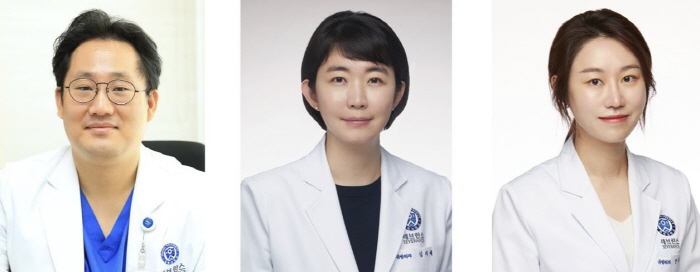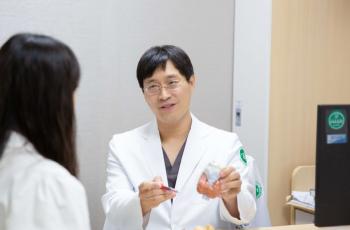Yonsei Cancer Hospital Breast Surgery for the World's First Robot in 9 Years
Aug 29, 2025
Yonsei Cancer Hospital recently surpassed 1,000 robotic breast surgery cases for the first time in the world.
Professors Park Hyung-seok, Kim Ji-ye, and Ahn Ji-hyun of the breast surgery robot surgery team at Yonsei Cancer Hospital announced on the 29th that they achieved 1,000 robotic breast surgeries for the first time in the world as of the 1st of this month.
After introducing robotic surgery for breast cancer treatment for the first time in Asia in 2016, it set the world's highest performance record in nine years.
Earlier, Yonsei Cancer Hospital set a new world record of 500 cases in July 2023 and broke the record in about two years, which is meaningful.
According to the 2023 National Cancer Registration Statistics, there were a total of 277,523 cancer cases in Korea in 2021, of which 28,861 breast cancer cases accounted for 10% of all cancer patients.
Breast cancer, one of the most common cancers in women, is accompanied by chemotherapy and adjuvant treatment, focusing on surgical surgery.
Breast cancer surgery includes a total resection that removes all of the breast, and a partial resection that removes only the tumor and part near the tumor.
Prior to the introduction of robotic surgery, the existing surgery directly incised the breast, leaving surgical scars from the front. However, robotic breast surgery removes cancer cells by making a window of 2 to 6 cm on the armpits or sides covered by the arms, not the breast, and putting robotic endoscopy equipment.
Patients are worried about leaving surgical traces on their breasts, but robotic breast surgery involves inserting thin robotic arms into their armpits or sides to operate on the inside of the chest, leaving few scars on the breast itself. Patient satisfaction is higher than that of existing surgery by reducing skin necrosis such as nipples.
In addition, it is easy to apply robotic surgery to preventive surgery. Prophylactic bilateral mastectomy can be safely performed to pre-remove the breast of patients with BRCA gene mutations that increase the incidence of breast cancer.
As such, robotic breast surgery is the best surgical method for patients undergoing preventive surgery to obtain both breast cancer prevention and cosmetic satisfaction through breast tissue removal.
Yonsei Cancer Hospital has various records following the first robotic breast surgery in Asia. Professor Park Hyung-seok, who recently introduced a surgical guide model incorporating artificial intelligence (AI), is a leader in the field as he performed breast cancer surgery using Da Vinci SP (Single Port), the latest robotic surgery model, for the first time in the world.
The breast cancer center at Yonsei Cancer Hospital is not only increasing the accuracy of surgery through robotic breast surgery, but also increasing patient satisfaction through multidisciplinary treatment with plastic surgery.
After the breast surgery robot surgery team completes the total mastectomy, the plastic surgery team (Professors Lee Dong-won, Song Seung-yong, and Yang Eun-jung) will undergo breast reconstruction surgery to rebuild the breast with prosthesis. Through this, we focus on protecting the self-esteem of patients following breast loss after surgery and improving patient satisfaction.
As such, robotic breast surgery at Yonsei Cancer Hospital is establishing itself as an integrated treatment strategy that encompasses treatment effectiveness, safety, aesthetics, and patient-centered approaches.
Professor Park Hyung-seok (Ballet Surgery) said, "Yeonseam Hospital's world record of 1,000 robotic breast surgeries exceeded the figures and would not have been possible without patients' trust in our hospital. Yonsei Cancer Hospital, which pursues safety and detail through robotic breast surgery, and adds beauty to various clinical departments and multidisciplinary treatments, will continue to pursue patient recovery and satisfaction."
Meanwhile, medical staff from leading hospitals around the world, including Harvard Medical School and Mayo Clinic in the U.S., as well as Korea, visit the site to learn the excellence of robotic surgery at Yonsei Cancer Hospital and learn techniques. The Severance Robotic Endoscopic Surgery Center developed its own breast robotic surgery technique using Kadeva in 2013 and applied it to actual clinical practice, and the excellent research power of Yonsei Cancer Hospital was also the basis for achieving 1,000 robotic surgeries.
Professors Park Hyung-seok, Kim Ji-ye, and Ahn Ji-hyun of the breast surgery robot surgery team at Yonsei Cancer Hospital announced on the 29th that they achieved 1,000 robotic breast surgeries for the first time in the world as of the 1st of this month.
After introducing robotic surgery for breast cancer treatment for the first time in Asia in 2016, it set the world's highest performance record in nine years.
Earlier, Yonsei Cancer Hospital set a new world record of 500 cases in July 2023 and broke the record in about two years, which is meaningful.
According to the 2023 National Cancer Registration Statistics, there were a total of 277,523 cancer cases in Korea in 2021, of which 28,861 breast cancer cases accounted for 10% of all cancer patients.
Breast cancer, one of the most common cancers in women, is accompanied by chemotherapy and adjuvant treatment, focusing on surgical surgery.
Breast cancer surgery includes a total resection that removes all of the breast, and a partial resection that removes only the tumor and part near the tumor.
Prior to the introduction of robotic surgery, the existing surgery directly incised the breast, leaving surgical scars from the front. However, robotic breast surgery removes cancer cells by making a window of 2 to 6 cm on the armpits or sides covered by the arms, not the breast, and putting robotic endoscopy equipment.
Patients are worried about leaving surgical traces on their breasts, but robotic breast surgery involves inserting thin robotic arms into their armpits or sides to operate on the inside of the chest, leaving few scars on the breast itself. Patient satisfaction is higher than that of existing surgery by reducing skin necrosis such as nipples.
In addition, it is easy to apply robotic surgery to preventive surgery. Prophylactic bilateral mastectomy can be safely performed to pre-remove the breast of patients with BRCA gene mutations that increase the incidence of breast cancer.
As such, robotic breast surgery is the best surgical method for patients undergoing preventive surgery to obtain both breast cancer prevention and cosmetic satisfaction through breast tissue removal.
Yonsei Cancer Hospital has various records following the first robotic breast surgery in Asia. Professor Park Hyung-seok, who recently introduced a surgical guide model incorporating artificial intelligence (AI), is a leader in the field as he performed breast cancer surgery using Da Vinci SP (Single Port), the latest robotic surgery model, for the first time in the world.
The breast cancer center at Yonsei Cancer Hospital is not only increasing the accuracy of surgery through robotic breast surgery, but also increasing patient satisfaction through multidisciplinary treatment with plastic surgery.
After the breast surgery robot surgery team completes the total mastectomy, the plastic surgery team (Professors Lee Dong-won, Song Seung-yong, and Yang Eun-jung) will undergo breast reconstruction surgery to rebuild the breast with prosthesis. Through this, we focus on protecting the self-esteem of patients following breast loss after surgery and improving patient satisfaction.
As such, robotic breast surgery at Yonsei Cancer Hospital is establishing itself as an integrated treatment strategy that encompasses treatment effectiveness, safety, aesthetics, and patient-centered approaches.
Professor Park Hyung-seok (Ballet Surgery) said, "Yeonseam Hospital's world record of 1,000 robotic breast surgeries exceeded the figures and would not have been possible without patients' trust in our hospital. Yonsei Cancer Hospital, which pursues safety and detail through robotic breast surgery, and adds beauty to various clinical departments and multidisciplinary treatments, will continue to pursue patient recovery and satisfaction."
Meanwhile, medical staff from leading hospitals around the world, including Harvard Medical School and Mayo Clinic in the U.S., as well as Korea, visit the site to learn the excellence of robotic surgery at Yonsei Cancer Hospital and learn techniques. The Severance Robotic Endoscopic Surgery Center developed its own breast robotic surgery technique using Kadeva in 2013 and applied it to actual clinical practice, and the excellent research power of Yonsei Cancer Hospital was also the basis for achieving 1,000 robotic surgeries.
|
This article was translated by Naver AI translator.














